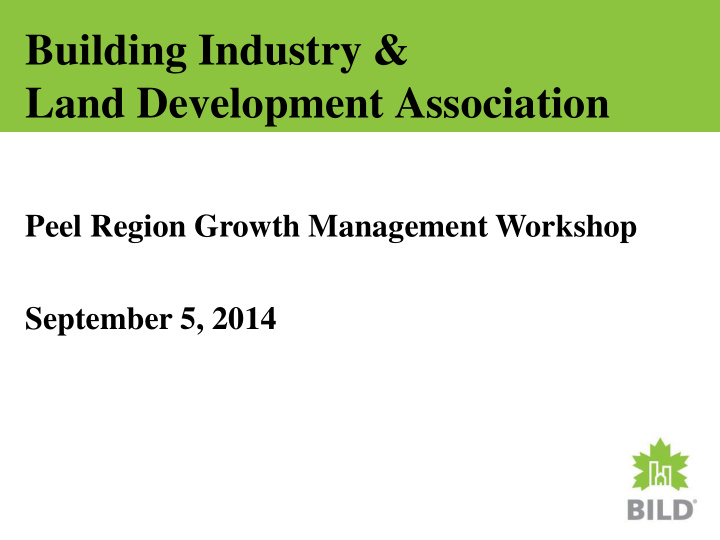



Building Industry & Land Development Association Peel Region Growth Management Workshop September 5, 2014
Today’s Outline: • BILD • Industry’s Economic Impact in the GTA & Peel Region • Development Charges 101 • The Development Charges – Bringing it back to Affordability • Why do we need Growth in Peel Region? • Financial Management Options • The Halton & York Model • Closing Remarks
BILD - • With more than 1,400 member companies, BILD is the voice of the land development, home building and professional renovation industry in the Greater GTA. • BILD also represents commercial, institutional, retail, and industrial land developers.
The Industry’s Economic Impact – Why Growth is Good! GTA:
The Industry’s Economic Impact – Why Growth is Good! PEEL REGION:
The Industry’s Economic Impact – Why Growth is Good! PEEL REGION: * According to CMHC, 2013
Development Charges 101 – who pays – what, where and why A 2013 Altus Group Study commissioned by BILD reveals: Since 2004 (for the municipalities studied), DCs have increased between 143% and 357%. Since 2005, the average selling price of new low-rise homes across the GTA has increased by 70%, and the average selling price of new high-rise homes has increased by 61%. In most municipalities, the most significant government charge for new homes are development charges: • For low-rise development, DCs represent from 38% to 47% of all government charges. • For high-rise development, DCs make up between 33% and 52% of all government charges.
Development Charges 101 – who pays – what, where and why Comparison of Changes in Average Price of Absorbed Single-Detached Units, DC Rates and Non- Residential Construction Price Index Average Price of Non-Residential Absorbed Single- Peel Region DC Rates Construction Detached Units, Price Index, Residential 1 Peel Region Industrial Non-Industrial Toronto CMA Year Dollars / Unit Dollars / Unit 2002 = 100 2004 335,790 6,874 27.58 38.24 110.5 2005 351,830 116.4 2006 401,144 124.2 2007 438,004 15,285 57.03 81.66 132.6 2008 481,063 145.3 2009 512,627 17,653 65.87 94.32 142.5 2010 551,896 142.4 2011 563,772 17,263 65.79 94.21 148.2 2012 586,200 35,567 88.94 128.44 151.5 2013 603,547 35,813 89.63 196.34 152.1 2014 (YTD) 630,403 36,071 135.82 197.75 153.6 % Change vs. 2004 88% 425% 392% 417% 39% % Change vs. 2007 44% 136% 138% 142% 16% % Change vs. 2011 12% 109% 106% 110% 4%
Development Charges 101 – who pays – what, where and why • Development charges are a legitimate source of revenue for regions and municipalities when used to offset infrastructure- related costs directly resulting from new growth. • BILD has always recognized this and the industry has never objected to paying their fair share. • On average, 56% of government charges are levied on land owners, developers, or home builders. Development Charges: • Charges levied during the development and/or building process are likely to get passed on to new home buyers. • Charges paid for by new home owners can have direct impacts on the amount of income available to pay for a mortgage, as well as other costs of living.
The Development Charges – Bringing it back to Affordability These absolute numbers reveal a significant impact on new home prices, directly reducing affordability, choice and opportunity for buyers
Why do we need Growth in Peel Region ? • Growth will occur in Peel Region. • Places to Grow: The Region of Peel is expected to reach 1.97 million population by 2041. • A report by the Canadian Centre for Economic Analysis titled Macroeconomic Evaluation of Water/Wastewater New Investment after 2031: • W/WW investments of $4B - $4.5B maximizes economic productivity and are required to maximize economic sustainability. • This leads to a higher standard of living, holds inflation in check, and enhances geo-regional competitiveness. • NO INVESTMENT = “Economic collapse of the Region.”
Financial Management Options: • Growth will occur in Peel Region (Growth Plan). • BILD does not support any deferral of required infrastructure projects within a DC by-law. • All large-scale core infrastructure (trunk sewers, plant expansions etc.) requires implementation on the current timeline, in order for the Region to meet the needs of future growth. • BILD supports expediting DC collection at subdivision approval or by pre-payment agreement and suggested the Region make this change to the DC collection process in the 2012 DC By-law review.
Pushing the Limits – The Halton Model ALLOCATION PROGRAM: Halton Region's Official Plan requires that an Infrastructure Staging Plan, including a financial and implementation plan, be prepared to Council's satisfaction prior to development proceeding: $23,503.00 – Local development charge (Oakville) $36,779 – Regional development charge $3,665 – Education development charge $1,032 – GO Transit DC +$27,516.00 – Region Allocation Charge (=cash-flow assistance/ the Region will not borrow) = $92,495 per single family home
The York Model: • The York Model collects hard (W/WW) DC’s at the subdivision approval stage. • The Region’s cash flow model would be improved and under less stress/risk. • EXAMPLE: • A 500 unit Subdivision would pay (W/WW)prior to registration vs as building permits would be issued over an approx. 4 year time frame. • BILD suggests that the subdivision agreements in Peel be updated to reflect this payment timeline .
Closing Remarks: • BILD looks forward to continuing the good working relationship with the Region of Peel. • We are at a critical juncture where we have to continue to work together to find a solution to the Region’s financial concerns. • We do not believe that the “Halton model” is a sustainable financial model. • Development Charges are working. • Region must look internally (value engineering) and externally (new funding sources) to reduce the cash flow risk. • BILD must be at the table in an engaged partnership role to solve this problem.
Thank you! www.bildgta.ca
Recommend
More recommend